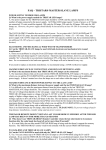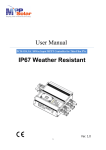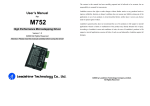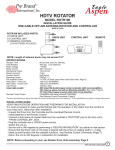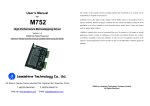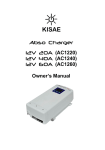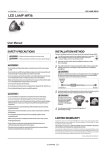Download FAQ – TRISTAR® LED Lamps
Transcript
FAQ – TRISTAR® LED Lamps ALL PRODUCTS POWER SUPPLY NEEDED FOR LAMPS Q. What is the power supply needed for TriStar LED lamps? A. The power supply for the TriStar LED lamps should be 12VDC and the capacity depends on the total number of lamps connected to the power supply. All TriStar LED lamps require 5 watts of power, so if 5 lamps are connected, 25 watts would be required, 100 watts for 20 lamps, 250 watts for 50 lamps, 500 watts for 100 lamps, etc. The PAVO-32 Controller also uses 5 watts of power. For a system with 1 PAVO-32 and 32 TriStar Lamps, the total maximum power consumption is: 5 watts x 33 = 165 watts. Thus, any power supply with 12VDC output and a minimum of 165 watt capacity could be used. 12VDC to 24VDC Q. Can the TriStar lamps be used with 24VDC or higher? A. All TriStar lamps can be used with power supplies from 10~24VDC, but preferably 10~17VDC/VAC. A power supply greater than 24VDC should not be used as this may damage the lamps. A power supply with 12VDC is recommended, however, you may use 13VDC or 15VDC if you are using long wiring, so that you can compensate for the voltage drop that results from the long wiring. SYNCHRONIZED COLOR-CHANGING OF NON-F (FREQUENCY) LAMPS Q. If you connect two or more TriStar E27, GU10 or MR-16 lamps (without the ‘frequency’ function) together, will they change in a synchronized manner using the pre-set color-changing modes of the IR Remote Controller? A. They will change in a synchronized manner for more than nine hours. If the power is turned off for eight seconds and then on again, the lamps will operate in the memory mode in a synchronized manner for another nine-hour-plus period. The TRISTAR-RGB F-SERIES lamps, however, have a frequency that allows the lamps to auto-synchronize when multiple lamps are connected to the same AC power source using the line switch. STAYING ON A SINGLE COLOR - BLUE Q. How do you get the TriStar lamps to stay on blue and, if the power is turned off, shine in blue again when the power is turned on? A. If the lamps are all on the same circuit, they should change in a synchronized manner. For lamps connected to a wall switch, you turn the light switch on and off until the lamps are blue. If the switch is not turned off again for 20 seconds, the lamps will retain that last color (blue) no matter how many times the light switch is turned on and off. The lamp won't change to another color (or light effect) until you turn the light switch on and off within 20 seconds. If you use the TriStar IR remote controller to change the lamps to a single color, they should again remain in the same position until changed by the remote. So if you use the remote to change the color of the lamps to blue, the lamps will turn back on with blue color until you change them with the remote. BEAM ANGLE WITH AND WITHOUT LENS Q. What is the beam angle of the TriStar lamps? A. The beam angle without lens is 60º. The beam angle with lens is 30º. E26 AND E27 BASE LAMPS Q. Is there a difference between an E26 and an E27 type lamp base? A. The E26 is slightly smaller than the E27. It is used in Japan. RATIONALE FOR SPECIFYING TRISTAR LAMPS AS 5W Q. Are TriStar LED lamps 3W lamps or 5W lamps? A. TriStar LED lamps are considered 5W lamps for the following reason: 1. Wattage is determined by amperage x voltage: W =I x V 2. A 1W LED obtains optimum current at 350mA and 4.0 volts. Each LED is 3.0-4.2V. 3. 4. 5. 6. W=IxV 0.35A x 3V = 1.05W/LED x 3 LEDs = 3.15 total watts minimum 0.35A x 4.2V = 1.47W/LED x 3 LEDs = 4.41 total watts maximum Since some energy is consumed in the circuitry, there is a total of 5 watts of power. SETUP AND CANCEL BUTTONS ON THE TRISTAR IR-1627 REMOTE CONTROLLER Q. What are the functions of the Setup and Cancel buttons on the TriStar IR-1627 Remote Controller? A. The Setup and Cancel buttons on the TriStar IR-1627 Remote Controller are used together with the PAVOControllers to give separate ID addresses to the TriStar SMART lamps. With separate ID addresses, the TriStar SMART lamps will change in the sequence of their ID addresses with lamp with ID No. 1 changing first, lamp with ID No. 2 changing second, etc. Up to 32 TriStar SMART lamps can be connected together with the PAVO-32 Controller. Up to 64 TriStar SMART lamps can be connected together with the PAVO-64 Controller and up to 96 lamps can be connected together with the PAVO-96 Controller. If the PAVO controllers are cascaded, or used with Repeaters, more than 15,000 lamps can be connected together for large lighting projects. REDUCING HIGH VOLTAGE INPUT TO EFFICIENTLY DRIVE LEDs IN TRISTAR E27 AND GU10 RGB LAMPS Q. How is the high voltage input of 100~240VAC into TriStar E27 and GU10 RGB lamps stepped down to power the three LEDs separately? A. The high voltage of 100~240VAC passes through a power board that first includes a rectifier to change the current from AC to DC and then a step-down transformer to reduce the voltage from 240V to 12VDC. Then there is a control board that provides a minor step-down from 12VDC to 5VDC to power each of the Red, Green and Blue LEDs separately. CE AND UL APPROVALS Q. Are the TriStar lamps CE and UL approved? A. The Tristar-GU10-RGB and TriStar-GU-10-Single Color lamps and the TriStar-E27-RGB and TriStar-E27Single Color lamps comply with the standards of Low Voltage Directive (LVD) for Safety Test. Passing this test is required for products to receive the CE mark. The Tristar-MR16, E27, GU10 including RGB and Single Color lamps, and theTriStar-MR16-Master and TriStar-MR16-Slave lamps, meet all requirements of the EMC (Electro Magnetic Compatibility) regulations. The TriStar MR16, E27 and GU10 lamps have also passed the test for the RoHS Regulations. RoHS is a new requirement for the EU that began July 1, 2006. The regulations require that no lead, mercury or other heavy metals are included in products sold to countries in the EU. The TriStar MR16 lamps are low voltage products, so they do not need UL approval. The TriStar E27 and GU10 lamps have not yet been submitted for UL testing. CONTROLLING MR16 RGB LAMPS UNDERWATER Q. Can the IR remote controller control MR16 lamps 500mm below the surface of water? A. Yes, it can, but if there are a group of MR16 lamps underwater, the IR remote may not be able to synchronize them. An alternative, and probably better, solution is to connect all of the MR16 lamps to an onoff switch. When you turn the switch on-off-on within two seconds, all the lamps will be synchronized. Then you can turn them off and back on within about 4 seconds and they will go to a different single color or a color changing effect - again, in a synchronized manner - each time you turn the switch off and on. THREADS ON THE SIDE OF THE MR16 Q. What are the threads on the side of the MR16? A. The threads on the side of the MR16 can be used for installing two extra springs for mounting purposes. After installing the springs (two stainless steel plates) you can mount the MR16 lamp directly to the ceiling without any additional fixture. STICKERS ON THE LAMPS Q. What is the purpose of the stickers on the lamps? A. The stickers are warranty seals. Customers should not open the lamps. If the sticker is broken, it will invalidate the one-year warranty of the lamps. TRISTAR SLAVE LAMPS NOT REACTING TO THE PAVO-32 Q. Why aren’t my TriStar SLAVE lamps reacting to the PAVO-32? A. The TriStar SLAVE lamps come with the default ID address of 1. If you connect them to the PAVO-32, without changing the ID address, the lamps will all be synchronized. Any color-changing effect from the PAVO will result in synchronized changes of the TriStar SLAVE lamps. If one or more lamps do not respond, connect them one at a time to the PAVO and reset the ID address to 1 according to the instructions of the PAVO-32 User’s Manual. PAVO-32 AND TRISTAR SLAVE LAMPS Q. Can the PAVO-32 be used with only the TriStar SLAVE lamps? A. Yes. You can connect up to 32 TriStar SLAVE lamps to a PAVO-32 using the D+ and D- terminals. If you want the TriStar SLAVE lamps to change in a synchronized manner, leave the ID address of the TriStar SLAVE lamps set at the default address of 1. If you want the lamps to change in sequence, then you must connect each lamp one at a time to the PAVO-32 and give each lamps a separate ID address (ID 1, ID 2, ID 3, etc.). After setting each TriStar SLAVE lamp, the lamps should be marked with its ID address so it can be connected in the order the user wants after all the lamps have been given ID addresses. CONNECTING MORE THAN ONE PAVO TOGETHER Q. Can I connect more than one PAVO together? A. Yes. You can connect PAVOs together using the RS485 Input Port. The first PAVO is the Master PAVO. The second PAVO is the PAVO Slave-1. When the user instructs the Master PAVO to apply color changing effects, the second PAVO, PAVO Slave-1, will send the same color changing effects to the lamps connected to it. Additional PAVOs can be connected to each other. The third PAVO, for instance, would be connected to the RS485 Input Port of the PAVO Slave-1. The third PAVO would be called PAVO Slave-2. NOTE: The maximum number of devices that can be connected to the PAVO-32 is 32. So if a second PAVO32 is connected to the first PAVO-32, then only 31 lamps can be connected to that first PAVO-32. CONTROLLING COLOR CHANGING EFFECTS WITH MORE THAN ONE PAVO Q. If I have more than one PAVO controller connected to each other, can I change the lamps from a PAVO Slave? A. Yes, but only the lamps connected to that PAVO, along with lamps connected to any PAVOs that come after the PAVO receiving color changing instructions, will follow the color changing instructions. The lamps connected to the PAVO-32 Master, or any lamps connected to a PAVO-32 Slave the comes before the PAVO32 Slave receiving the color changing instructions, will not respond to the instructions. Using multiple PAVOs, you can obtain tiered color schemes. RECOMMENDED TRANSFORMERS Q. What are the recommended transformers for TRISTAR-MR16 lamps? A. It is recommended that a 12VDC transformer be used with TRISTAR-MR16 lamps. It is also possible to use a 12VAC toroidal transformer or a 12VAC magnetic transformer. Electronic transformers can work 95% of the time, but they can sometimes be unstable. (The lamps will not be harmed if electronic transformers are tried.) The user needs to use a trial and error approach. 12V AC/DC STANDARD TRANSFORMERS Q. Can the TriStar Master-Slave lamps be used with a 12V AC/DC standard transformer? A. Yes, the TriStar RGB Master-Slave lamps can be used with a 12V AC/DC standard transformer. FLEX Q. Do the TriStar Slave lamps need to use the flex (four-wire cable) A. At the present time, you’ll need to use the flex (four-wire cable) with the slave lamps. We think of the lamps being connected in a parallel manner rather than a series. MAXIMUM DISTANCE OF CONNECTION Q. What is the maximum distance that TriStar Slave lamps can be connected? A. The maximum distance that can be used with the TriStar Master-Slave lamps is 100 meters. It doesn’t matter how close the lamps are to each other within that range. DIFFERENCE BETWEEN TRISTAR SLAVE AND TRISTAR SMART LAMPS Q. What is the difference between the TriStar SLAVE and the TriStar SMART lamps? A. The difference between the TriStar SLAVE and the TriStar SMART lamps are in the way you set the ID address of the two types of lamps and the fact that the TriStar SMART lamps have an IR receiver that allows them to be controlled directly by the TriStar IR Remote Controller. TriStar SLAVE lamps have a default ID address of 1. If you want to give the SLAVE lamps separate ID addresses, you need to connect each one separately to a PAVO-32 Controller and follow the instructions in the PAVO User’s Manual. TriStar SMART lamps can be given ID addresses after they are connected to the PAVO-32 by using the TriStar IR Remote Controller. The “Set/Cancel keys for RS485” on the TriStar IR Remote Controller can be used to set the ID address of one or more TriStar SMART lamps. By pointing the TriStar IR Remote Controller to one or more SMART lamps and pressing the “Set” key, any lamp within range of the IR remote controller will be ready to respond to instructions from the PAVO-32 Controller. (Follow the instructions of the PAVO-32 User’s Manual to set the ID address.) If you want only one TriStar SMART lamp to respond to the ID address given, you must cover up the other SMART lamps to prevent their IR receiver from receiving the instructions. CONTROLLING COLOR-CHANGING EFFECTS FROM THE PAVO-32 AND THE TRISTAR IR REMOTE CONTROLLER Q. Can color-changing effects be controlled by either the PAVO-32 or the TriStar IR Remote Controller? A. The PAVO-32 can control color-changing effects with the Tri-Star Master-Slave lamps, the TriStar Slave lamps when connected to the PAVO-32 without a TriStar Master, and the TriStar SMART lamps. The TriStar IR Remote Controller can be used to control the PAVO-32, a TriStar Master lamp and the TriStar SMART lamps. The TriStar Slave lamps do not have an IR receiver to receive instructions from the TriStar IR Remote Controller. If you point the TriStar IR Remote Controller to a TriStar Master lamp, any color-changing effects sent to the TriStar Master will be automatically sent to all the TriStar Slave lamps connected to the TriStar Master. The TriStar IR Remote Controller can give instructions for color-changing effects to individual TriStar SMART lamps, or to the PAVO-32, which in turn will send the instructions for the color changing effects to all the TriStar SMART lamps connected to it in the sequence of their ID addresses. CANNOT GET ‘TRUE WHITE’ COLOR FROM TRISTAR RGB LAMPS Q: Why is the white color in the TriStar RGB lamps not a “true white” color? A: The white in RGB lamps comes from the mixing of the RGB LED chips. The white is always cool and can be pinkish because it is difficult to get a good balance from the mixing of R, G and B. This is a natural feature of color changing lamps. If you want a true white color for an extended period, it is better to use a single-color white LED lamp than an RGB lamp. TRISTAR MR16-RGB LAMPS STAYING IN SYNCH IN FADE AND SMOOTH MODES Q: Will the TriStar MR16-RGB lamps stay in synch in the fade and smooth modes? A: You may keep the TRISTAR-MR16-RGB lamps synchronized when using AC/AC transformers. If you are from the USA, you will be using a 110VAC-12VAC magnetic transformer, and connect all of the TRISTAR lamps to the secondary side (12VAC) output. You may use a large transformer (100 Watts) to drive up to 20 TRISTAR lamps. Then you can use the On/Off switch on the secondary side, to switch to the different modes built inside the TRISTAR lamps and keep all of them synchronized, including while in the Fade/Smooth modes. CABLE DISTANCE BETWEEN POWER SUPPLY AND TRISTAR LAMPS Q: What is the maximum length of cable that can be run from a power supply to a 12V TriStar 5W lamp? A: The only concern for a long power line would be the voltage drop at the end of the power line. The 12V TRISTAR LED lamps can be powered by a voltage range between 10V and 17V. If you need to wire a long distance, you can use a high voltage power source. The voltage output of some power supplies can be adjusted to its high side. If you have a fixed 12VDC or 12VAC power supply, and you need a long wire run, then you may use bigger gauge power cables for connection. Or if you have to wire many lamps on the same power cable, you would also need a larger gauge cable. For example, if you want to wire 10 TRISTAR lamps to a pair of 20 gauge power cables with a 12VDC power supply, and all of the lamps are tied to the very end of the cables, then you will have a maximum current output of 5 Amps, 500mA x 10 Lamps = 5 Amps. The resistance for a 20 gauge wire is 1 ohm / 100 ft, so the maximum voltage drop would be 5 Volt / 100 ft, (V = I * R, 5 Volt = 5 Amp * 1 ohm) and you are allowed only to drop the voltage by 2 volt (12 - 10 =2), so the maximum cable length would be 40 ft. In any case, we would recommend that you use a higher voltage power supply, say 15 volt for a long distance run. LUMENS AND LUMINOUS FLUX Q: The R2 Warm White has 105 lumens. How far away do you measure this luminous flux – 1 metre or closer? A: Lumens are a measurement of the total photonic output. It doesn’t change with distance. Lux is the unit for the flux level at a certain distance. The unit is lumens/m2. In other words, if the lamp is 3 meters above you, it will light up a large area in circumference and have a certain flux level. But if the lamp is above a desk, say two meters, then the circumference of the area lit is smaller and the flux level is greater. The lumens of the lamp, however, stay the same. (You can check the web for details on this.) BRIGHTNESS OF R2 COMPARED TO MR16 HALOGEN BULB Q: Is the R2 comparable in brightness to an MR16 halogen bulb? A: Halogen lamps will generate around 18 lumens/watt, while the R2 has an actual output of 35 lumens/watt. The light pattern or beam angle of a halogen lamp is usually wider than the R2. The R2 has a beam angle of 60 degrees. The Lux level of the R2 is equivalent to a 20-watt halogen lamp. PHYSICAL SIZE OF R2 AND MR16 HALOGEN DOWNLIGHT Q: Can the R2 directly replace an MR16 halogen downlight (the same physical size)? Its voltage is 10~17 Vdc/Vac, so can it take either ac or dc voltage within this range? Please confirm. A: The physical size of the R2 is compatible with the MR16 halogen lamp. Some electronic 12VAC transformers may not be able to power up the R2. The electrical load of the R2 (3 watts) is too low and sometimes it can not be picked up (or sensed) by many electronic transformers. COLOR VARIATIONS Q: Will the color(s) vary on an LED lamp over time? A: Yes. An LED lamp is a semi-conductor product, so while they are more durable than incandescent or fluorescent lamps there are still many factors involved. Heat and temperature can result in some color variation over time, but this is not something we can control. Some degradation of the phosphor may take place after a period of time due to humidity and temperature variations that can affect the color consistency. Up to now, there is no practical, economical solution to this issue. USE OF MR16 LAMPS IN SAUNAS Q: Can the TRISTAR-MR16 lamps be used in saunas? A: No. The operating temperature should not be over 50° C. It is very difficult to obtain a thermal isolation in a sauna to achieve this because the ambient temperature of saunas is generally 85° ~ 100° C. The LEDs will be dead if the ambient temperature exceeds 100° C







